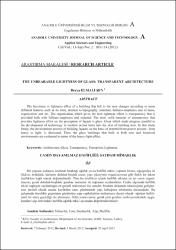The Unbearable Lightness of Glass: Transparent Architecture
Abstract
The heaviness or lightness effect of a building that left to the user changes according to some different features such as its form, relation to topography, structure, fullness-emptiness rate of mass, organization and etc. The organization which gives the best lightness effect is transparency that is provided both with fullness-emptiness and material. The most valid material of transparency that provides lightness effect on the perception of façade is glass. Glass which made progress parallel to the development of technology in modern period turns into the skin of building now. In this study firstly, the development process of building façades on the basis of material from past to present -from heavy to light- is discussed. Then, the glass buildings that built in both new and historical environments are evaluated in terms of the heavy-light effect. Bir yapının kullanıcı üzerinde bıraktığı ağırlık ya da hafiflik etkisi; yapının formu, topografya ile ilişkisi, strüktürü, kütlenin doluluk-boşluk oranı, yapı yüzeyinin organizasyonu gibi farklı bir takım özelliklere bağlı olarak değişmektedir. Tüm bu özellikler içinde hafiflik etkisini en iyi veren organizasyon, gerek doluluk-boşlukla gerekse malzeme ile sağlanan saydamlıktır. Cephe algısında hafiflik etkisi sağlayan saydamlığın en geçerli malzemesi ise camdır. Modern dönemde teknolojinin gelişmesine paralel olarak aşama kaydeden cam, günümüzde yapı kabuğuna dönüşmüş durumdadır. Bu çalışmada öncelikle geçmişten günümüze yapı cephelerinin malzemeye dayalı olarak -ağırdan hafife-nasıl bir süreç geçirdiği ele alınmıştır. Daha sonra camın, gerek yeni gerekse tarihi çevrelerdeki uygulamaları algı üzerindeki hafiflik-ağırlık etkisi açısından değerlendirilmiştir.
Source
Anadolu Üniversitesi Bilim ve Teknoloji Dergisi A - Uygulamalı Bilimler ve MühendislikCollections
- Cilt.13 Sayı.2 [8]


















